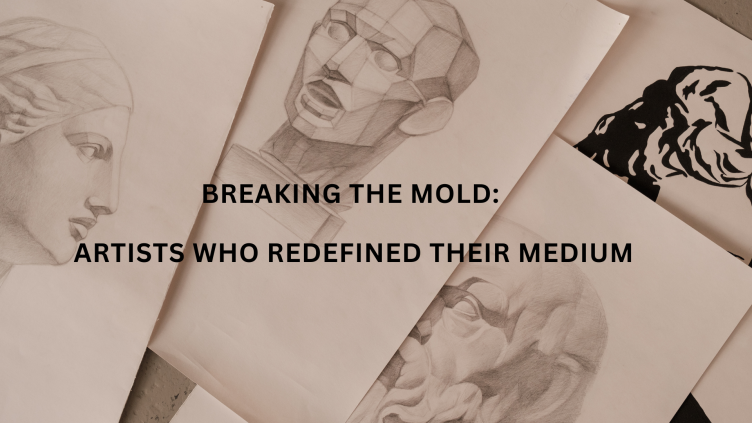Welcome to Riya’s Blogs! Today, we’re diving into the fascinating world of artistic innovation. If you’re passionate about art, creativity, and the stories behind groundbreaking masterpieces, you’re in for a treat. In this article, we explore the incredible journeys of artists who have not only pushed the boundaries of their chosen mediums but have also transformed them into something entirely new. These visionary individuals didn’t just follow the established rules—they reinvented them. So, grab your favorite beverage, get comfortable, and let’s embark on a journey through the world of art that breaks the mold.
1. Marcel Duchamp: The Father of Conceptual Art
Marcel Duchamp is a name synonymous with art that challenges conventions. In the early 20th century, Duchamp made waves with his concept of “readymades”—everyday objects presented as art. His infamous piece, Fountain (1917), a standard urinal signed with the pseudonym “R. Mutt,” sparked outrage and discussion. Duchamp’s approach was revolutionary; he shifted the focus from the aesthetic quality of the artwork to the idea behind it. By doing so, Duchamp opened doors for the conceptual art movement, which focuses on the concept or idea rather than traditional visual aspects.
Duchamp’s influence is still felt today, particularly in the realms of contemporary art and installations. His work challenges viewers to reconsider their definitions of art and aesthetics, making him a pioneer in breaking traditional artistic molds.
2. Jackson Pollock: The Pioneer of Abstract Expressionism
Jackson Pollock’s name is synonymous with abstract expressionism, a movement that emphasized spontaneous, automatic, or subconscious creation. Pollock’s unique technique, known as “drip painting,” involved dripping or pouring paint onto a canvas placed on the ground. This method allowed Pollock to create complex, energetic compositions that defied traditional painting techniques.
Pollock’s work, such as No. 5, 1948, is characterized by its chaotic and dynamic nature. His approach to painting was revolutionary, turning the act of painting into a physical performance. Pollock’s influence extends beyond abstract expressionism; his innovative methods have inspired countless artists to explore new ways of creating and perceiving art.
3. Yayoi Kusama: The Queen of Polka Dots and Infinity Rooms
Yayoi Kusama’s work is instantly recognizable for its bold use of polka dots and immersive infinity rooms. Kusama, who has been creating art since the 1950s, combines elements of psychedelia, minimalism, and surrealism in her pieces. Her signature style involves repetitive patterns and vibrant colors, creating a sense of boundlessness and infinity.
One of Kusama’s most famous contributions is her “Infinity Mirror Rooms,” which use mirrors to create the illusion of endless space. These installations invite viewers to experience art in a completely new way—by immersing themselves in a seemingly infinite environment. Kusama’s innovative use of space and pattern challenges traditional perceptions of art and continues to captivate audiences around the world.
4. Banksy: The Enigmatic Street Art Revolutionary
Banksy, the anonymous British street artist, has redefined what it means to create and display art. Known for his provocative and politically charged works, Banksy’s street art often appears in public spaces, challenging conventional gallery settings. His pieces, such as Girl with a Balloon and The Flower Thrower, combine stenciling techniques with powerful social commentary.
Banksy’s approach to art democratizes access, making it possible for people from all walks of life to engage with his work. By placing art in public spaces, he transforms everyday environments into galleries, questioning the elitism often associated with the art world. Banksy’s influence extends far beyond street art, prompting discussions about the role of art in society and the boundaries of artistic expression.
5. David Hockney: The Digital Art Trailblazer
David Hockney is a renowned British artist known for his contributions to painting, drawing, printmaking, and photography. In recent years, Hockney has embraced digital technology, using iPads and iPhones to create stunning artworks. His digital pieces, such as The Arrival of Spring in Woldgate, East Yorkshire, demonstrate how traditional artistic techniques can be translated into the digital realm.
Hockney’s foray into digital art has expanded the possibilities of artistic creation, showcasing how technology can enhance and transform traditional mediums. His work highlights the potential for digital tools to contribute to the artistic process, inspiring a new generation of artists to explore the intersection of technology and creativity.
6. Jeff Koons: The Master of Kitsch and Pop Art
Jeff Koons is a contemporary artist known for his large-scale, often controversial works that explore themes of consumerism, popular culture, and kitsch. Koons’s art, including pieces like Balloon Dog and Michael Jackson and Bubbles, often incorporates shiny, reflective surfaces and familiar, everyday objects.
Koons’s approach challenges traditional notions of art and taste, blurring the lines between high art and mass culture. His work often sparks debate about the nature of art and its role in contemporary society. By recontextualizing popular culture icons and consumer products, Koons redefines what constitutes art and pushes the boundaries of artistic expression.
7. Kara Walker: The Provocative Storyteller
Kara Walker is an American artist known for her powerful and provocative works that address themes of race, gender, and history. Her silhouette installations and paper cutouts, such as those in A Subtlety, use stark black-and-white imagery to confront and critique historical and contemporary issues.
Walker’s art challenges viewers to confront uncomfortable truths and engage in conversations about identity and history. Her innovative use of silhouette as a medium allows her to explore complex social issues in a visually striking and thought-provoking manner. Walker’s work continues to influence and inspire discussions about art’s role in social and political discourse.
Conclusion
These artists have redefined their respective mediums, breaking free from traditional constraints and reshaping the art world in the process. From Duchamp’s readymades to Kusama’s immersive installations, their innovative approaches have not only expanded the possibilities of art but have also challenged our perceptions of what art can be.
At Riya’s Blogs, we celebrate these trailblazers who have transformed the art world with their creativity and vision. Their contributions remind us that art is not static but a dynamic and evolving field where new ideas and approaches continuously emerge. If you’re fascinated by the ways in which artists push boundaries and redefine their mediums, stay tuned for more inspiring content right here at Riya’s Blogs.







